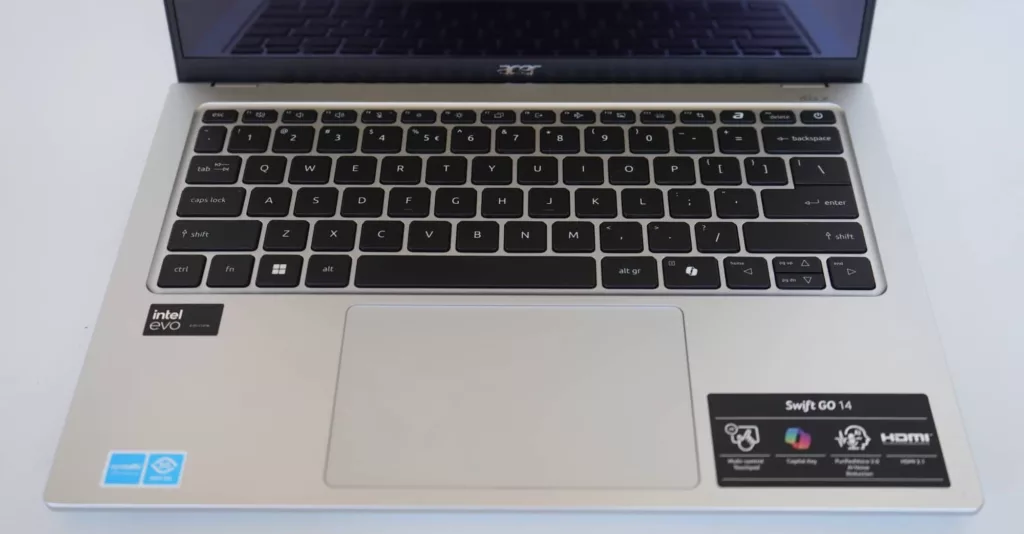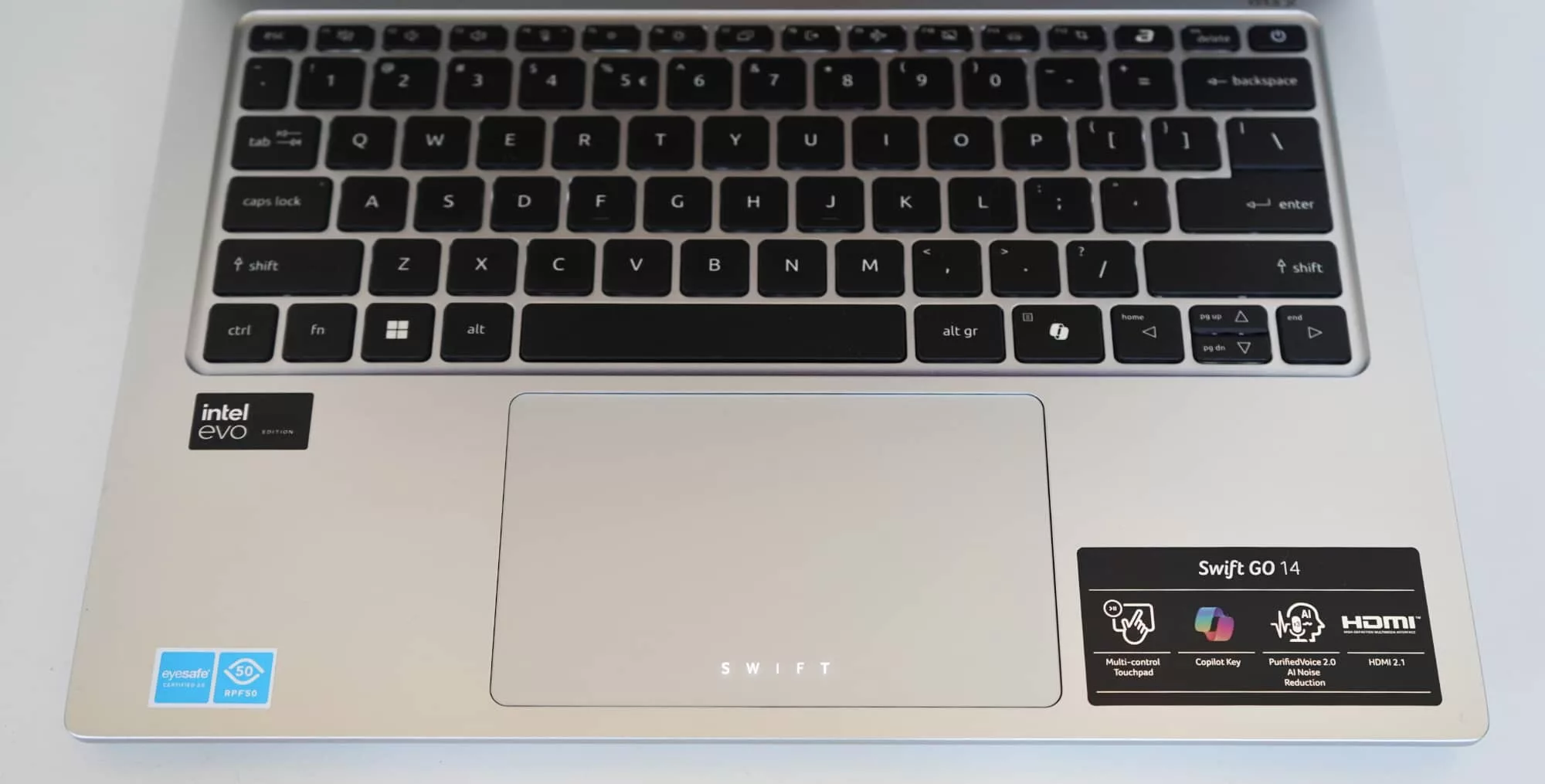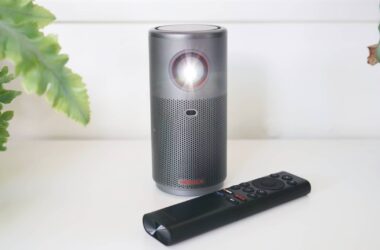Quick review
The good
The not-so-good
Our first official Intel AI PC that we’re checking out, the 2024 Acer Swift Go 14 sports the Microsoft Copilot key and an Intel-capable AI chip inside, the Acer Swift Go 14 aims to offer a balance of power and value. Does it succeed?
Design
Simple yet easy enough on the eyes, the aluminium-clad Swift Go 14 is nice to look at, but isn’t elegantly metallic and minimalist like a MacBook and looks a bit thicker by comparison (it is).
But the look is still pleasing, and a far cry from the old days of plastic-backed Acer lappies that felt like you were buying something less premium.
By comparison, the 1.3kg Acer Swift Go 14 appears robust yet modern, with slight angles on the underside as if a Transformer had toned down to something socially acceptable (sorry, Optimus Prime and co).
The underside of the casing is a little flexible and it’s clear there’s either some space there or not every component is pressed in tight, but provided you don’t drop the laptop hard, we don’t see any problems here.

Features
Worth pointing out that you shouldn’t drop any laptop (try not to!), particularly a new laptop with as much decent hardware inside as this one.
This is the first laptop we’re reviewing to feature Intel’s latest chips, a breed of Core that includes neural processing inside. Officially, it’s the Intel Core Ultra 7 155H complete with neural processing (NPU) for AI loads, a chip that’s paired with 16GB RAM and 512GB SSD, as well as Windows 11 Home.
That should be plenty to work with, and you’ll find a reasonable amount of connection options, as well.
In the wireless world, there’s Bluetooth 5.3 and WiFi 7, the latter of which makes it fairly future proof and backwards compatible with 802.11ax WiFi 6 networks. Meanwhile, the physical connections cover one HDMI port, one USB 3 Type A rectangular port, one 3.5mm headset jack, and two USB 3 Type C ports with Thunderbolt 4 support, as well.
There’s also a small webcam and microphone, plus a couple of speakers in the design, plus a sizeable battery charger that offers a 100W of power. It’s probably way more than a machine of this size needs, but that’s Acer’s call. If you decide to get a second charger, you may want to consider one of the 145W models out there, or something even meatier.
| Model | Acer Swift Go 14 (SFG14-73) |
| Chip | Intel Core Ultra 7 155H 1.40GHz |
| RAM/Storage | 16GB RAM; 512GB |
| Display | 13 inch OLED, 2880×1800 |
| OS | Microsoft Windows 11 Home |
| Connections | WiFi 7, Bluetooth, HDMI, 3.5mm, microSD, Thunderbolt 4/USB-C |
| Size/Weight | 14.9mm, 1.3kg |
| Price | Starting from $1899 AUD |
Display
Alongside a decent spec, you’ll also find a decent display that’s easy on the eyes. It seems we’ve come a long way from the days of mediocre screen panels and resolutions lower than Full HD. That can only be a good thing.
In the Swift Go 14, Acer has provided a 14 inch OLED panel running 2800×1800, a resolution that is clearly greater than Full HD and gives you a little more to work with in terms of pixel clarity.
Beyond that improvement to the res, the OLED screen is clear and vibrant, supports 90Hz, and one of the surprising features on a machine coming in under $2K. You won’t get touch support, mind you, even if the hinge allows the screen to push all the way back, something that surprised us greatly.
Contrary to how the design looks, you’re not going to be using this as a tablet, and instead will need to rely on the keyboard and mouse.

In-use
That’s both good and bad, because the usability is a bit of a mixed bag.
On the one hand, the keyboard is fairly nice, providing a decent set of keys and tactility to work with as you type, and that’s a good thing.
A fingerprint sensor is built into the power button on the right, making for a handy way of logging in easily, and you even get that new Copilot key if you want to bring up Microsoft’s in-built AI in a jiffy if you like (we used it once and never again).
The mouse on the other hand… that’s less good.

To Acer’s credit, it’s a wide and spacious trackpad with a rather unnecessary light-up “Swift” at the bottom that you need to dig into settings to work out how to turn off. That’s not a great look. But at least it’s not as frustrating as the trackpad itself, which feels difficult to click.
Somewhere between too firm and poorly implemented, the Acer Swift Go 14 trackpad just didn’t work well for us, dampening the whole experience. Pressing down on the large pad often felt broken, and needed more heavy-handed pressing than we’d have otherwise liked.
A mediocre mouse can make or break a laptop experience, and with this one, it certainly didn’t help. There are certainly better laptop mice out there.

Performance
There’s plenty of performance for folks who need it, though, with Intel’s latest chip beating at the heart.
You’ll find the Intel Core Ultra 7 155H inside, a chip that runs at a meagre 1.4GHz, but still manages to deliver reasonably solid performance, whether you’re looking at synthetic benchmarks or running your own apps.
Compared with the last generation on Intel chips, there’s a pretty sizeable difference in capability, with some tests of the new models absolutely flooring what we saw in 2023. That’s great, and it’s even solid against Apple Silicon in the M2 and M3 models.
They still don’t necessarily hold a candle to Apple’s chips when it comes to graphics using Metal in the M3 MacBook Air, however.
It wouldn’t be fair to judge apples and oranges, or even Apples and Acers, largely because Mac isn’t Windows and Intel’s x86 chip architecture isn’t quite the same as the ARM used in Apple Silicon.
Even still, there are some clear speed increases in the synthetic benchmarks that put the M3 Air ahead of Acer’s Intel Core Ultra model.
In real-world usage, running apps on this system is easy as, and you shouldn’t have any problems whatsoever.
Mostly made for productivity and the odd casual game, the Acer Swift Go 14 can handle work and some play, but it is by no means a gaming machine. You’ll be able to have a little bit of entertainment, and the included DTS:X sound is handy, too.
There’s also support for AI features, but working out what those are isn’t always easy. There’s support for AI enhancement in video chat and conferencing apps, improvements to the microphone, and AI art apps that can remove backgrounds from photos and apply depth tweaks to photos, but that seems to be roughly it.
The ChatGPT-connected Copilot is also connected on the laptop for your ChatGPT needs, part and parcel of Windows 11, but it appears to run online as opposed to locally, so you’re not exactly making use of the hardware AI functionality yet.
Keep in mind that Windows AI PCs are still quite new, and there aren’t a lot of apps that take advantage of what they should be able to do. This should change in time.
Overall, it’s fairly balanced little machine, and one that should provide more than enough capability for most users.

Battery
Battery life is a little less positive, largely because our hopes for an all-day battery life was slightly dashed in this model.
Maybe it’s we’ve been spoiled by Apple’s ability to handle over 10 hours without fail, or maybe we’re just a little too hopeful, but we wanted the Acer Swift Go 14 to nail a similar battery life, and it just couldn’t. In our tests, at most we managed to get around 8 hours of battery, which isn’t bad but also could be better.
At least you don’t need to haul around a random circular charge cable. While the brick isn’t as compact and sexy as what Apple makes, Acer follows the USB-C compliance of the rest of the world, meaning all you really need to do is bring a meaty power supply, and the Swift Go 14 will charge comfortably.

Value
Priced at $1899 in Australia, Acer’s Swift Go 14 seems like an acceptable price for what’s on offer, targeting what is basically normally the $2K mark for hardware like it, and slightly undercutting it.
It’s a minor saving compared to the $1999 Lenovo Yoga S7i with its 14 inch OLED screen, and a more noticeable savings compared to the $2500-$3200 price tag that normally sees 13-14 inch laptops with the latest Intel Core AI PC chips.

There’s also a minor difference to the $2099 M3 MacBook Air, though comparing MacBooks and Windows PCs isn’t always fair.
In short, the sub-$2K price tag gives Acer something to work with: it’s one of the more affordable premium 14 inch AI PCs out there.

What needs work?
One thing we’d love for Acer to improve is the trackpad, which feels difficult to press at times, lacking the tactile feel we look for. It’s there, but you really have to press hard. Most of the time, it’s like tapping a piece of glass that doesn’t want to move, and it just doesn’t feel great.
There’s also a light-up “Swift” at the bottom of the trackpad, but you really need to dive into one of the many extra apps Acer includes on Windows 11, which is a thing.
At least two distinct Acer control panels control some of these features; Acer Control Center in the control panel is an outdated app with no touchpad control and a defrag option for an SSD (something that surprised us immensely), while AcerSense found in the Windows start menu actually gave us the control for the touchpad lighting.

And that’s only the start of the extra apps this thing comes with, which is just littered with them. Littered is definitely the right word, which includes:
- App Explorer
- ClipChamp
- Elvenar
- Evernote
- Express VPN
- Forge of Empires
- Luminar Neo
- Solitaire
- Spades
- and a few others that we probably missed, plus some links to websites.
It is staggering just how much bloatware Acer has loaded onto this laptop. The good news is it doesn’t affect the sizeable 512GB storage too much, but the bad news is you have to deal with the unnecessary apps.
Consistency between Acer’s apps would be appreciated, but so too would the company not making life complex with useless apps you don’t need.
We get it, by the way: bloatware makers often pay hardware makers to make sure these apps are installed on a laptop out of the box, which makes it some form of annoying preset marketing. Frankly, it’s just wasteful.

Final thoughts (TLDR)
Bloatware aside, Acer’s Swift Go 14 is an easy consideration if you’re after something that not only does the job, but achieves it in a portable and friendly way with plenty of power.
We wish the design was a little thinner and the trackpad a lot better, but there’s plenty to consider in the Swift Go. It’s a surprisingly capable machine worth checking out.







